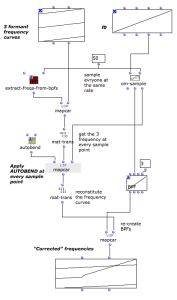Formants and vocal simulation
The Chant synthesizer is based on the vocal production model and can be very good at imitating voiced (or voice-related) sounds. In order to obtain realistic voice sounds, the FOFs must be finely tuned and parameterized. The following tools of OM-Chant facilitate this process.
Vowel parameters and databases
VOWEL-FORMANTS is the main function available to get the frequency, amplitude and bandwidth values of the FOFs permitting the to model sung vowels.

VOWEL-FORMANTS returns 4 lists: a list of formants formatted as ((freq1 amp1 bw1) (freq2 amp2 bw2) ...), and then the separate lists of frequencies, amplitudes and bandwidths. Basically, and as visible in different previous examples, these 3 lists are suited to be connected to the slots freq, amp and bw of he CH-FOF and CH-FILTER events.
A second, optional input of VOWEL-FORMANTS allows to choose between dB or linear values for the amplitudes. In OM-Chant in principle, the amplitudes are considered and set in linear mode.
DATABASE-FORMANTS is an alternative function allowing to choose among a personalized formant database. An example is given in the tutorial patch "vowel-formants".
Control Rules
OM-Chant provides a number of functions for the automatic computation or correction of synthesis parameters.
These functions (or "rules") are inspired from experimental research carried out in the 80s by the Chant project team.
- AUTOAMP calculates the amplitude of the formants depending on the frequencies and bandwidths, taking into account the interactions between formants (reinforcement of the amplitudes of formants approaching one another).
- AUTOBEND adjusts the frequencies of the formants depending on the fundamental frequency.
- AUTOBW calculates the bandwidth of the formants depending on the frequencies.
- AUTOTEX calculates the FOF 'tex' parameter (in seconds) from the bandwidth and skirt width of a formant.
- FCOMP calculates the amplitude a complement formant to be added to the spectrum.
- CSLOPE allows to control the spectrum in relation to the dynamic amplitude of the sound, the type of voice which is being used, and the fundamental frequency.
- SPCOR adjusts the formants amplitudes according to the duration of the attacks of the FOFs and the bandwidths of the respective formants.
Use d to see the functions' reference pages and get detailed descriptions.
The Chant rules can be used in arbitrary control processes to modify or correct synthesis parameters. In particular, they can be embedded in iterative processes to apply "continuously" on evolving sets of parameters.

